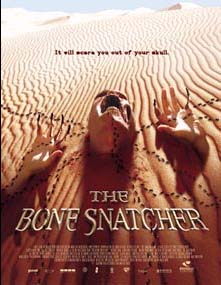From Overseas Entertainment, a relative unknown in the industry, comes a picture eerily reminiscent of 1950s horror.
"The Bone Snatcher" comes with subtitles and a set of three trailers, including its own, and two others: Hollywood North and Between Strangers. Neither is even vaguely related to the movie, or to horror in general, or even horror's bastard son, science fiction. It's really rather strange that they'd add these two trailers onto a movie about giant ants.
Set in South Africa, FILMED in South Africa, and subtitled only in Spanish for some reason (I admit I was half-expecting Afrikaans), this is a vaguely familiar story of geologists as superheroes.
Boy, bet you never thought you'd hear THAT one, eh? Eh?
We open on a nuclear reactor in crisis - a meltdown narrowly averted by the quick thinking of scientists. And the reward for their leader's quick thinking? A posting in scenic, far-off Africa!
African DESERT, too. Nothing around for miles and miles and kilometers. The stark emptiness of the desert is truly striking in an era where just about every movie playing takes place somewhere picturesque. And of course the people are a pleasure to work with - within five minutes we're treated to an almost loving description of how human urine can be distilled into water so pure that it rivals Himalayan snow melt. I found my own sentiments echoed from one of the crustier characters.you can leave me the snow melt, thanks.
And then we're treated to one of my least favorite film conventions, a dolly shot. That is, a camera moving forward rapidly with a filtered lens to make it seem as though something is moving forward in a hurry, and we're "seeing through their eyes." I give it the generic name of "He-Who-Walks-Behind-The-Rows-Vision," after the Children of the Corn series, the first place I encountered it. It is, needless to say, an old convention, and old conventions are TIRED conventions.
Several minutes later, our party arrives at its destination, to search for water in the desert. Our party arrives to find the sight of several flesh-stripped corpses. Some of which have their heads detached. Of course, our party is understandably alarmed and begins trying to piece together what happened.
People start disappearing.
Strange things begin shambling through the desert.
Mechanical failures plague the team, removing their one major advantage. Their truck breaks down in the middle of the desert, and their radio begins to fail. Now, with their supplies running low and their lifelines cut, the team must race against time to figure out what's going on in the African desert.and how they can survive it.
And indeed, what do we find? It's a kind of ANT that's responsible for the whole thing!
Which leaves our scientist friends with one central purpose-eliminate the colony of giant ants who only appear to be harming scientists who get too close to their colony in the desert. Yeah, boy.that could be a real threat, couldn't it? But if they were to get out of the desert there could be some real problems. So, there needs to be some explosion that turns some giant ants into some giant ant bits.
Now, let's digress for a moment here to talk about a movie called "Them!" "Them!" is also about giant ants in the middle of the desert that terrorize human populations. Of course, here, the difference is the population is much smaller, especially in the beginning. We find that in "The Bone Snatcher," things could be much worse for human populations if these ants get out of the desert in one piece, whereas in "Them!", the harm is already about to come to pass. But the basic thematic elements are the same. Giant ants, risk to humans, scientists standing in the gap. It's interesting when you think about it.
Why would South Africa decide to revive the "giant ant" genre? Did they think it would be best for them with their environment and resources available? Or did they just think it would be a quick way to cash in on Americans' insatiable desire for pure blood-n-guts horror?
Is this a statement on the world's environmental leanings-a cautionary tale in the making about chemicals and nuclear materials?
Dracula's Curse

From Artisan Home Entertainment, who is rapidly becoming the most prolific provider of direct-to-video titles since Full Moon Entertainment's heyday of the early to mid-nineties, comes another title possibly related to Bram Stoker.
Bad news right off - there are only Spanish subtitles, so if you enjoy them or need them you're plain old out of luck on this one. Deleted scenes also make an appearance, covering up some loose ends. Other features are also included - watch at will.
Bram's been having a heyday these last few years, and this Italian picture is proof enough of that. Yet another retelling of the legend of this partly real, partly fictionalized Euro-Slavic-Something-or-Other Prince.
Most of the standards are here.we have Jonathan Harker, Mina Harker, Renfield and that old Dracula hisself, along with all the others. But we have a surprising amount of modern touches infused here. Modern Italian sports cars - at least it LOOKS Italian, I'm not a car buff-and cell phones make appearances alongside the old legends.
Stranger still, Dracula now looks strangely like Kevin Kline in "French Kiss." Complete with hideous mustache. I don't know about anyone else but I've never seen a vampire with facial hair. And predictably, he also has a problem with the Christian God, telling anyone who'll listen at length about how "God is a murderer."
Yet at the same time our coffin bound Count (though he doesn't enjoy being called such - too old fashioned! Can you believe it? The schmuck lives in the middle of Eastern Europe, in a by-God CASTLE, and he thinks being called "Count" is old fashioned.) is a religious sort of fellow. Of his own religion, anyway.he rants endlessly about "final conflicts" and "superiority to the animals". And of course let's not forget about how our dear Count is raising an army for this "final conflict". Which is most of the Count's motivation in the film-vampirism makes soldiers.
And then, in a scene of outright surrealist glee, Jonathan and Mina are married in the middle of a hospital following Jonathan's car crash whilst escaping for our roaring contradiction of a vampire. You haven't seen a wedding until you've seen old men in hospital johnnies handing out bouquets and a man in a wheelchair wearing a tiara as the groom. It wins PRIZES for being strange. Really.
So we have plenty of departures from the classic here. We have cell phones and souped-up sports cars and angry gun-toting border guards running about, but we also have the old standbys. For instance, Dracula's need to have Romanian grave dirt around him at all times. Dracula's ability to change forms into mists, bats, rats, wolves. Dracula's marked susceptibility to crosses and holy water. All the oldest parts of the legend are in tact.
In fact, Dracula also develops delusions of grandeur, plotting global domination with an army of vampires at his control. But Harker and company set out to put an end to Dracula's plans in classic style -contaminating his coffins with holy water, destroying the pure Romanian grave dirt, and so forth.
After nearly being rebuffed by several pieces of the legend, Dracula goes after revenge in the form of Harker's new wife Mina. Turned into a vampire, Mina is now the weapon of choice for Harker and company's plans. They set a trap for the vampire prince, waiting for him to come back to a willing food source.
In a true surprise twist, Mina slams a stake into Dracula's ribs. Seems she's not as turned as we thought. So, at least for the Harkers, a happy ending is realized.
Now, some points of discussion to expound on:
Notice the use of faith and religion in the movie. How even Dracula himself claims to be a believer - keeps Bibles in his castle - and yet is turned away by other parts of faith. Are we looking at a commentary on the duality of man? Or are we looking at a subtle critique of the modern era church?
Even more interesting is when one character mentions that the best way for an evil threat to all mankind to stay hidden until it's too late to prevent or fight back against its attack is for it to become perceived as fiction. Sure! If I had a small arsenal of laser weaponry, why wouldn't I release science fiction movies as a way to dissuade the populace from believing they existed? "That's all fake," folks would scoff. Right up until the very moment they were running in terror, dodging fire from those very same "science fiction" weapons. And by then, there would be nothing they could do to stop it.
Note the commentary at the end. How is a life measured? By success? By relationships?
Or by something else entirely?
Are legends so universal that they can be reworked into the modern era without qualm? You'll see here how a story written well before the invention of the automobile manages to assimilate their existence into its confines.
"Dracula's Curse" is a surprisingly engaging retelling of an old legend put almost seamlessly into the modern era. It's quite a surprise to me that a story over three hundred years old could be modified so handily to fit our times.


